Email marketing is one of the most widely used promotional channels. Because the competition is so fierce — 93% of B2B business owners use newsletters to connect with target audiences and acquire leads, it’s getting increasingly harder to get the recipient’s attention.
Hence, there’s no room for mistakes. However, no matter how brilliant your HTML email templates are, we all may commit those mistakes when reaching out to clients.
Top 15 Email Marketing Mistakes to Avoid
As you are working on a newsletter, there are a lot of things that can go awry at any moment. From putting a broken link inside the copy to rendering issues, the effects of email marketing errors can go anywhere from ‘whatever’ to a full disaster.
To be sure your emails represent the company in the best way possible, make sure to avoid the following mistakes:
Mistake 1. Buying subscriber lists or sending unsolicited emails
Since it takes time to curate a custom subscriber base, some marketers look for an easier way out — such us purchasing a ready-to-go email database. Buying ready-to-deploy subscriber lists is one of the most common marketing mistakes. At first, it seems a perfect way to reach out to thousands of people, but in the long run, it turns out that purchasing an audience is not a viable marketing strategy.
However, you should try to avoid the approach because the audience of the database didn’t sign up for an email — to most readers, your email will be irrelevant so they will quickly flag it as spam. Every time your corporate email is reported is one time too many since the email client will filter it, and your email will not reach even genuine readers.
As we know, being flagged as spam affects deliverability of future campaigns. Find other reasons that affect it in this Ultimate Email Deliverability Guide.
Even when collecting your database manually, when adding to your list only those users who registered with your website or for an upcoming event, you need to get the user’s permission.
According to the GDPR regulations and to the CanSPAM rules, users, when subscribing for your newsletters or joining your site, must check the “I give my consent” box manually, on their own.
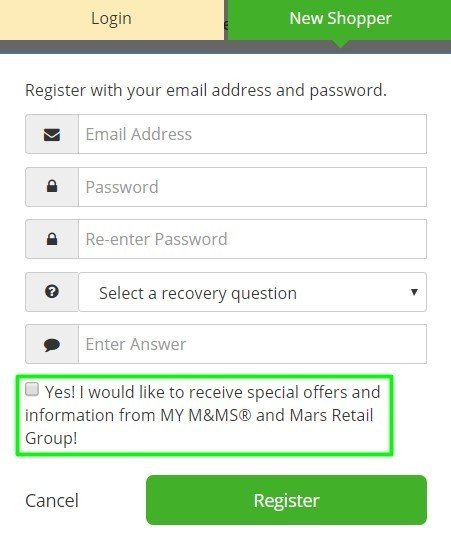
(Souce: Registration form on the M&M’s website)
Otherwise, your newsletters are considered unsolicited.
Mistake 2. Not welcoming subscribers
When users register with your website, they expect a certain reaction from you. We’re talking about welcome emails.
Normally, in such emails, brands share with users instructions on how to use their tool, share the most recent blog posts, or the most popular product items.

(Source: Newsletter email from MoneyWise)
It would be nice of you to notify subscribers about how often you are going to reach out to them and what will be in those newsletters. Be sure to highlight your strengths.
You may also add your personal e-signature if you like.
Send a welcome/a series of onboarding emails. Build a necessary workflow with your ESP.
Remember that the first email should go the minute your new subscriber registers with your site or signs up for newsletters.
Mistake 3. No consistent content marketing strategy
It’s impossible to overrate the importance of campaign planning and setting clear goals for every newsletter you send.
In all marketing efforts, consistency is key. One of the worst mistakes in email marketing is sending newsletters sporadically as readers will have no habit of interacting with your content, have no idea when to expect a new email from you, or even forget they subscribed in the first place.
Besides, as mentioned above, in welcome emails you let customers know how often they will “hear” from you and what those emails will be about.
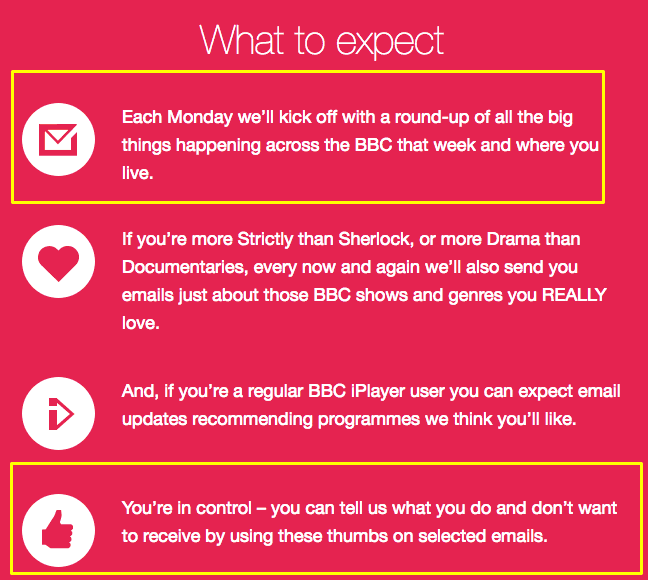
(Source: Newsletter email from BBC)
So, creating an editorial calendar is a way to build long-term communication strategies and a base of engaged readers. Sending emails out on set days of the week, with fixed timing, helps the audience create a ritual of interacting with your email as soon as it’s out and wait for new content.
Mistake 4. Errors in email texts
There are different views on typos. While some find these email marketing mistakes super annoying and would never deal with the company that put ‘Your missing out’ in the subject line, others consider them an efficient way to get readers’ attention.
To start with, let’s distinguish between the two most common types of errors email marketers commit when working on email copy:
-
typos — e.g. abuot vs about;
-
grammos — e.g. you’re vs your.
To make sure typos or grammar errors are not a turn-off for readers, try following these simple tips:
-
install a spell-checker, like Grammarly, Ginger, TrustMyPaper, etc.;
-
avoid long sentences and complicated clauses — they leave you at a higher risk of grammar difficulties;
-
proofread your emails manually to catch passive voice misuses and other stylistic issues.
Mistake 5. Underestimating the power of subject lines
The subject line is the frosting on the ‘email’ cake. Although it doesn’t offer the main value of the email, it creates the first impression and decides the fate of your open rates. Here’s the tip list to take into account when penning subject lines:
-
3-word subject lines have the highest engagement rate according to SendGrid;
-
“Soon” is a better time marker to use than “now”;
-
“Free” in subject lines has become a conversion-killer, dropping engagement rates by 4%;
-
going overboard with subject line creativity confuses the reader. Tell the audience clearly what the email offers, without hiding behind metaphors or buzzwords.
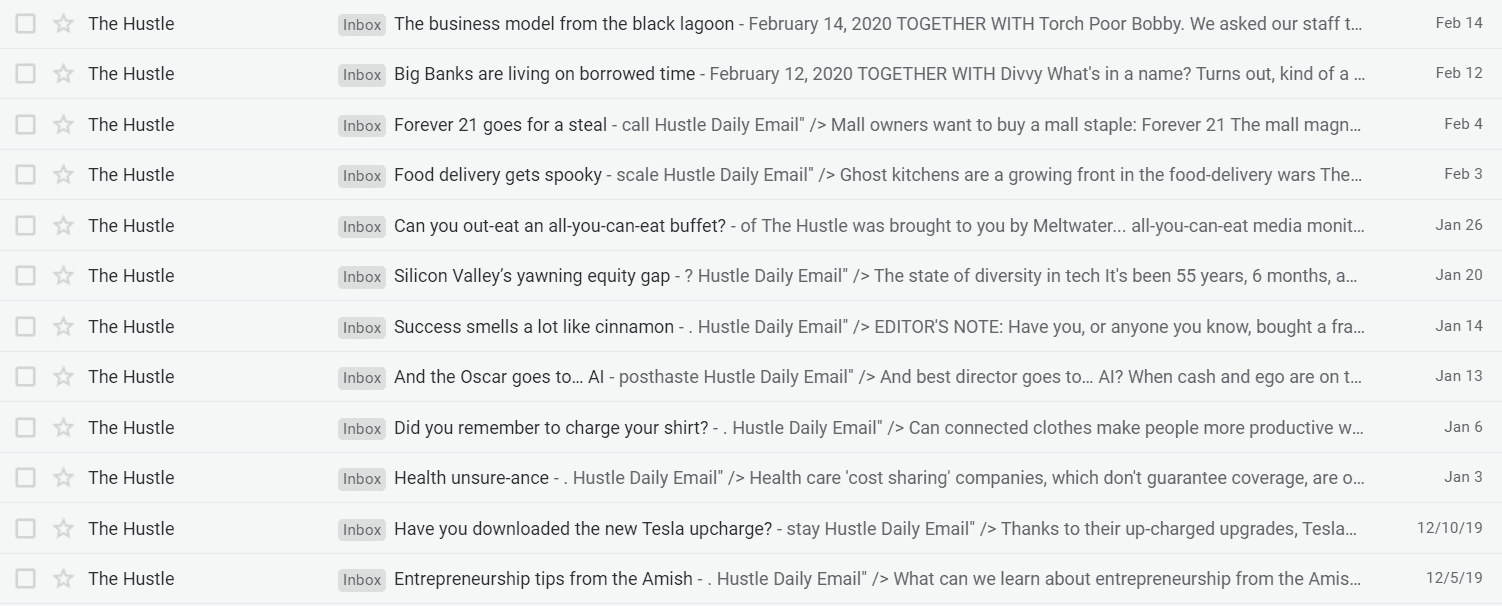
(The Hustle subject line examples)
In my opinion, The Hustle is extremely skilled at writing catchy and witty subject lines. Take a look at how the content team keeps the copy creative, funny, and short.
Mistake 6. Poorly personalized emails
Striving for personalization is great — it promotes your brand as considerate and caring. According to GetResponse, personalized subject lines have a 24% open rate, while generic ones are opened by 21% of recipients; personalized email body has a 3.89% CTR compared to 3.29% CTR of non-personalized emails.
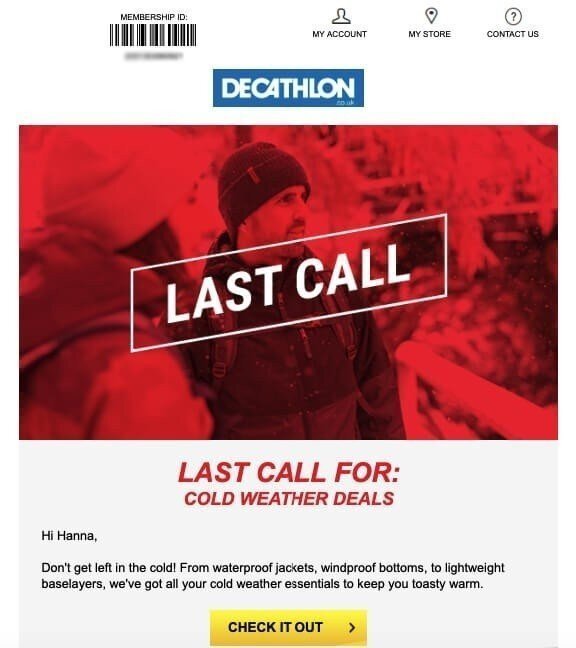
(Source: Newsletter email from Decathlon)
Because personalization is such a powerful tool, the worst mistakes in email marketing come at a high cost. Just by the experience of our clients, most issues marketers face have to do with personal data tokens. If you use [FNAME] or other tags, make sure to test if they are displayed right before sending out the email. Otherwise, you might end up in an awkward situation and call a recipient the wrong name or just have ‘Dear [FNAME] in the copy.
Please be advised:
You can add merge tags to your email copy for your specific ESP with Stripo.
In their A to Z blog post — the personalizing copy section — they in detail show how to do it.
Mistake 7. Old or incorrect links
CTR is one of the most important metrics for email marketers. Newsletters rarely have much standalone marketing value — however, they are a powerful tool to connect a prospective customer to the website or a social media channel.
We harness the potential of emails by adding links to it. Naturally, sending a newsletter with a broken or the old link will deal a lot of damage. The most common email marketing mistakes connected with links are:
-
forgetting to add a link to the email;
-
linking to admin accounts or documents that only the team can view;
-
linking to different offers than those promoted;
-
directing a reader to a 404 page;
-
using links from previous newsletters. Happens quite often when using templates.
To make sure all of your links are functioning and secure, use a link testing tool — there are a lot of free tools you can try.
Mistakes 8. Not having a clear CTA
Call to action is the climax of your emails. You’re focusing readers with all your email content towards it.
It should be easy for readers to guess at first glance what the main idea and the main goal of your email is.
.png)
(Source: Newsletter email from Hilton Honors)
When working on an email, make sure CTA buttons are noticeable, have a clear call to action copy and have proper URLs.
See the types of buttons here.
Mistake 9. Non-accessible email layout
Another worst email marketing mistake is not building accessible emails.
We tend to forget about those who use screen readers.
People may do it for various reasons: permanent or temporary visual impairments, busy when driving/cooking, etc.
Some recipients who suffer from color blindness cannot distinguish, say, green on red and vice versa.
Dyslectics might not be able to read our emails when we use no full stops or semicolons at the end of a line or bulleted lists. And you never underline links in email accessible emails.

(Source: Made up email)
We know you will find a bunch of email marketing mistakes examples in your Inbox. But we made up the example in order not to use email sample by real brands here
No worries — all emails built with Stripo are adjusted to screen readers. You cannot see it in the code. Stripo adds necessary code elements when exporting emails to any ESP/CRM.
Find more details on how to make your emails accessible in Stripo’s respective blog post.
Mistake 10. Non-mobile friendly emails
Missing out on mobile users means letting go of dozens of prospective leads and major conversion boosts. Statistically speaking, we use smartphones to check the inbox more frequently than computers. 61% of Americans answer emails via mobile.
However, email marketers are still slow in adopting mobile-friendly design practices. Sending out visually-rich but non-responsive emails is one of the top mistakes in email marketing that prevents business owners from effortlessly connecting to mobile audiences.
Make sure the email builder that you use provides you with fully responsive email templates.
You can make all the images you add to your emails responsive by just toggling the respective button.

Apart from that, you can set different font sizes and button width when working on email design with Stripo.

See how to fully optimize your emails for mobile devices with Stripo in their “Responsive Email Layout” blog post.
Mistake 11. No testing
From your template editor to the recipient’s inbox, an email goes through around 15,000 renderings. From the alignment of elements to the text and image size, the view of the email might change drastically depending on the device, browser, or email client the reader is using.
With that in mind, business owners need to adopt the ‘Test it before you send it’ mentality. Here’s a short checklist of the red flags to watch out for when testing emails:
-
whether links are displayed correctly;
-
whether email design renders correctly;
-
the look of the subject line and the preview;
-
the legibility of fonts on different devices and browser clients;
-
image displaying across different platforms;
-
the integrity of the email code;
-
whether all ‘alt’ tags are present.
There are plenty of tools for email deliverability testing. Feel free to use platforms like Mailtrap — a simulated SMTP server that helps ensure every recipient will get your message.

Such tools allow business owners to not spam readers and keep all test emails in one inbox.
Mistake 12. Failing to automate workflow/drip campaigns
Sending emails out manually might be managing as long as you have a medium-size subscriber base. However, as the audience scales, keeping up with the campaign without automation is impossible.
Email marketers are often cautious about using automation tools as it’s a commitment both in terms of time, effort, and money invested in software. However, in the long run, automation is a way to build a sustainable communication strategy.
Here are some of the many tasks an automation solution helps optimize:
-
building complex email campaigns — you build them once, they work for you and your clients for a long time. Drip campaigns are mostly meant for trigger emails;
-
tracking and monitoring — with automation software, you will know how many people opened the email, interacted with it, deleted, or flagged the emails as spam;
-
strategizing. Automation tools help build sales funnels and ensure all of your campaigns are effective and goal-driven;
Mistake 13. Not segmenting subscribers
If you have a large audience, it’s hard to create an email that’s equally relevant to hundreds of thousands of people. That’s where segmentation comes into play — dividing subscribers into groups based on their interests, education, pain points, buying needs, and other criteria. Then, an email marketer creates newsletters that will resonate with these people on a deeper level.
The power of segmentation is not up for debate — according to Mailchimp statistics, segmented emails are opened 14% more often. By missing out on this stage, you are lowering the efficiency of future campaigns and making them less manageable.
To segment email marketing audiences efficiently, marketers usually use these criteria:
-
geographic — country and city of residence, native language, the best time to send newsletter emails. Ikea sent their email shown below to residents of Burbank and Carson cities;

(Source: Newsletter email from Ikea)
-
demographic — gender, age, social and marital status;
-
psychographic — interests, hobbies, education;
-
behavioristic — customer journeys, on-site behavior, social media posting habits.
Mistake 14. Running several campaigns aimed at the same audiences
As a rule of thumb, expert marketing teams try to not involve one segment in multiple campaigns at once. Otherwise, you might end up sending people conflicting emails, lowering the audience’s satisfaction and trust to the brand.

Three emails per day seem like a little bit more than a regular customer expects.
If you want to test different emails on an audience with similar interests, break the segment down into two even subgroups and send a different newsletter to each. This way, you will be able to choose a better-performing strategy without jeopardizing the company’s credibility.
Mistake 15. Neglecting campaign analytics
Most marketing teams don’t run promotion campaigns across a single channel at a time — rather, you have to juggle PPC ads, social media promotion, and email marketing at once. As a result, it’s hard to distinguish high-performing strategies from failing ones.
To make data-driven marketing decisions, you need to be well-aware of how subscribers react to all the content that you put out.
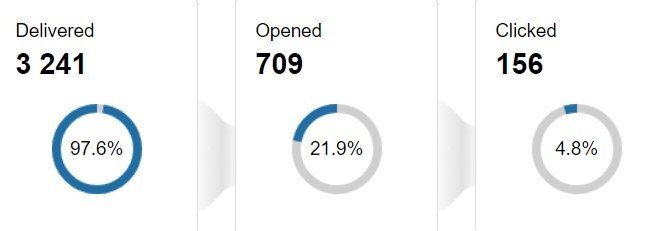
(Source: Screenshot of statistics of our email campaigns at eSputnik)
That’s why email marketers track the performance of every email by capturing relevant metrics:
-
open rate;
-
click-through rate;
-
bounce rate;
-
unsubscribe rate;
-
revenue per email;
-
ROI of the email.
To see a big-picture view of your marketing strategy, consider compiling the following reports:
-
top five campaigns — collect data on campaigns with the highest ROI and analyze what led to their success;
-
top five user journeys — based on the insights collected from email marketing, find the most efficient way to guide a visitor through the website and generate new leads;
-
email delivery rate by geography. If you are targeting multiple markets, it’s useful to have the general idea of deliverability for each area;
-
Engagement by device — to make sure your emails are well-optimized for computers, smartphones, and tablets alike, collect data for all these platforms and make sure there are no drastic differences in engagement rates.
Conclusion
Usually, email marketing means aiming at millions of prospective readers from all over the world. With a huge range of devices, platforms, interests, and behavior habits to take into account, pleasing every subscriber on your list is next to impossible.
Having said that, most email marketing turn-offs come from rookie mistakes.
In this post, we investigated the pitfalls marketers normally face and shared tips on how to avoid email marketing mistakes.
By testing your campaigns, writing content that resonates with readers, and aiming at long-term strategies, you will reduce the spam rate for your emails and will be able to create a dedicated audience of brand fans.
To design responsive, ready-to-deploy newsletters, consider using Stripo.
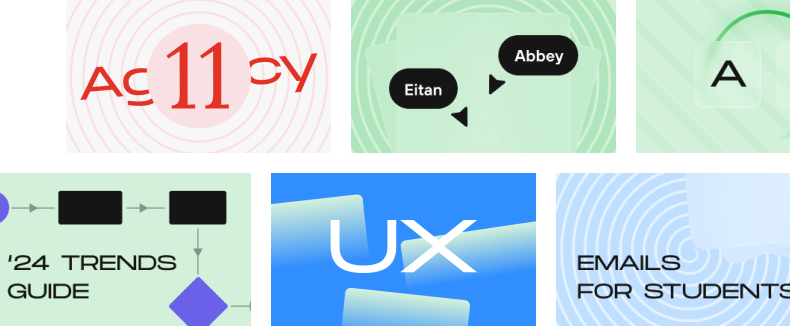




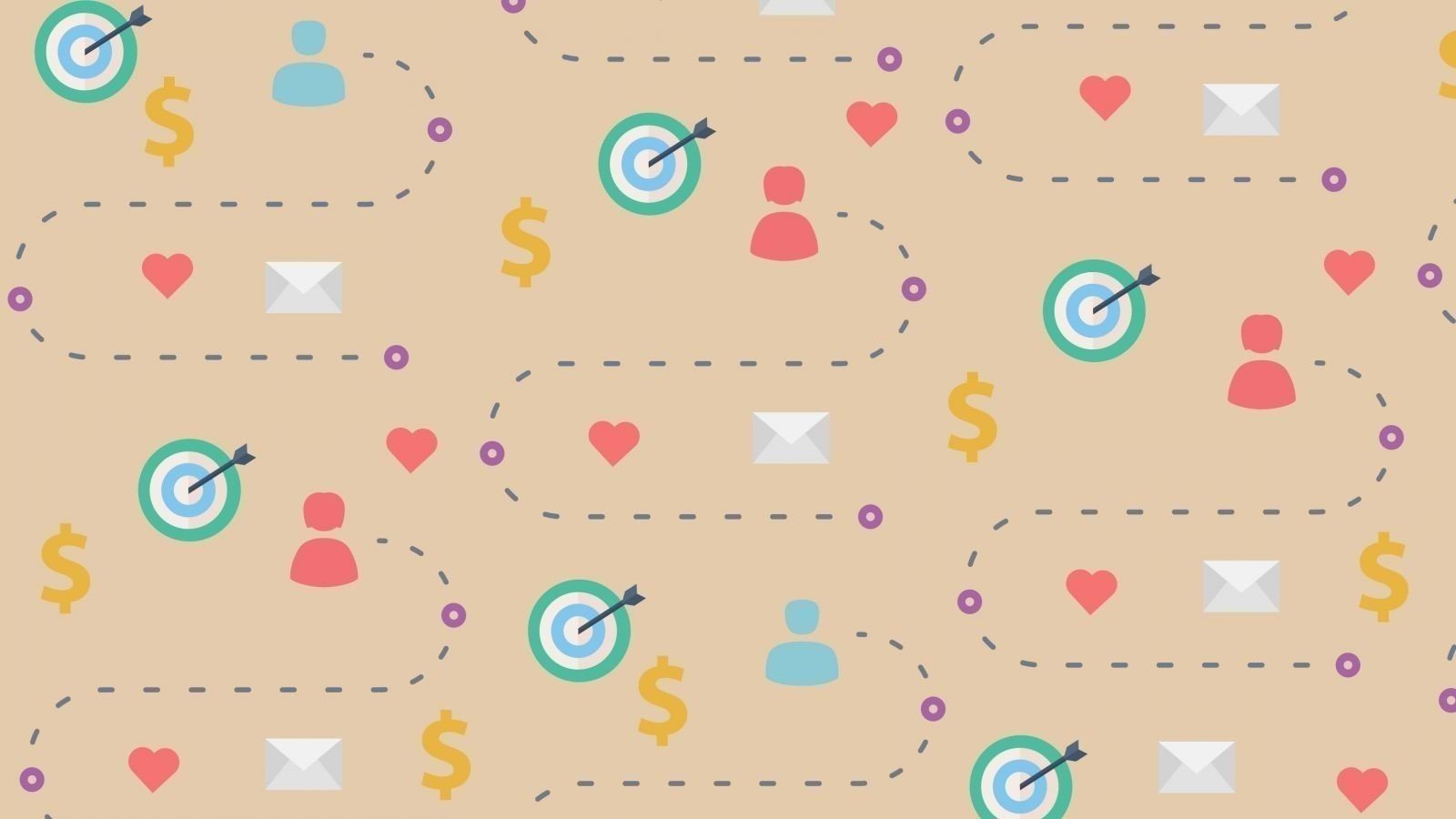


2 comments